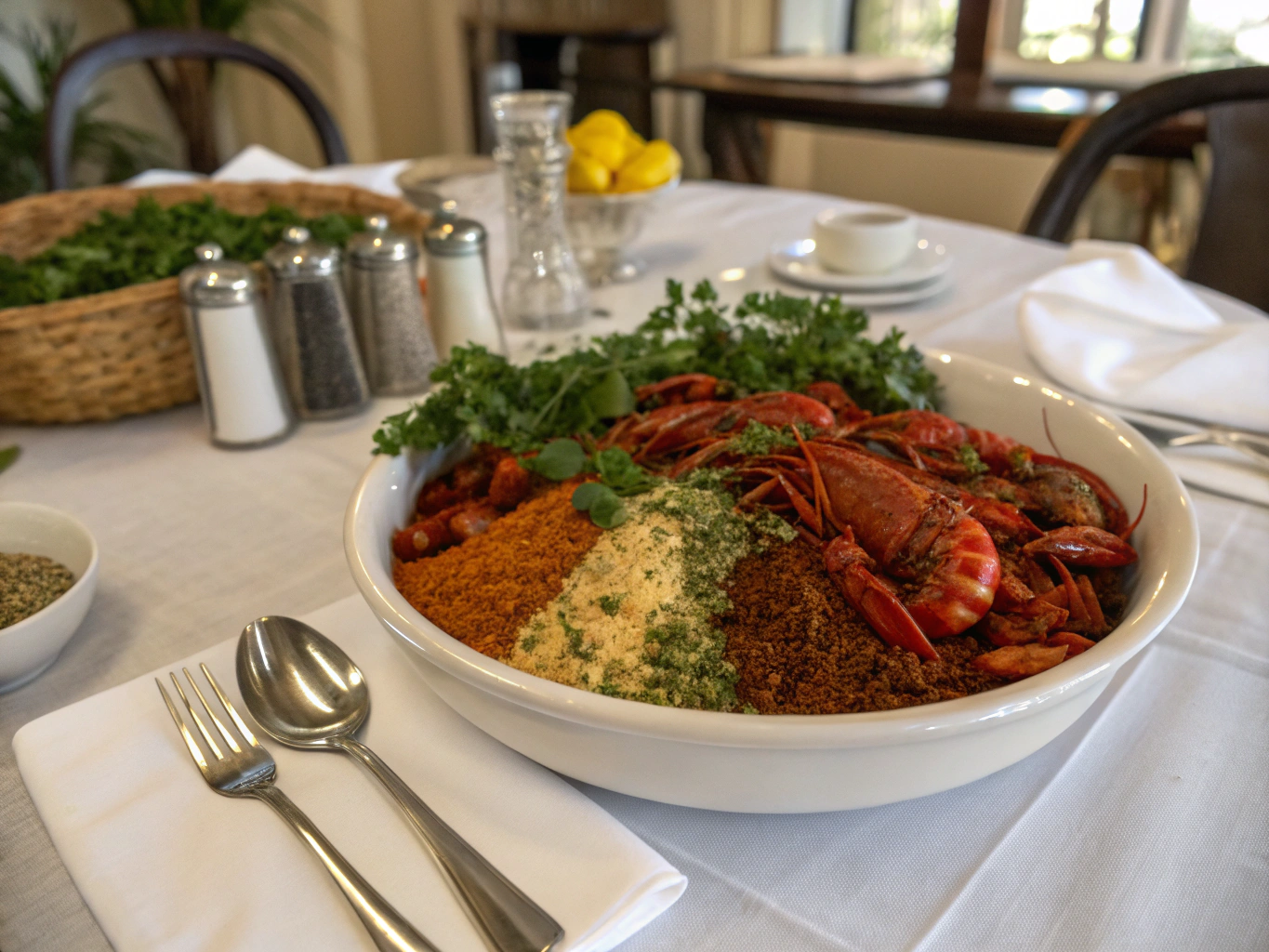
If there’s one seasoning I always keep in arm’s reach, it’s Cajun seasoning. It’s the flavor of family cookouts, seafood boils, and the bold charm of Southern spirit you can shake right into your skillet. This article dives deep into making your own Cajun seasoning, where it comes from, why it’s magical, and how to use it like a pro. From scratch-made blends to clever substitutions, you’re getting the full scoop—plus a reliable FAQ and helpful links to level-up your comfort cooking game.
The Heart & Heat Behind Cajun Seasoning
A Southern Kitchen Memory
Cajun seasoning holds a special place in my kitchen and in my heart. As a Charleston native, my earliest memories of cooking involved watching my grandmother stir something bubbling, savory, and smoky on the stove. She never measured, just cooked by scent—which probably explains why I stirred my first gumbo way too long and almost set off the smoke alarm. But oh—it was flavorful! That’s when I learned the power of seasoning done right.
Cajun seasoning is more than just a spice mix—it’s a story. It tells of resilience, community, and flavor-bravery rooted in Louisiana’s blend of French, African, and Native American influences. When I launched FlavivoRecipes.com, blending inspiration with tradition, Cajun mix was the first homemade seasoning I posted. Why? It’s approachable, customizable, and brings the heat without overpowering comfort.
I started crafting my own version after being disappointed by store-bought mixes that were either too salty or lacked that authentic smoky tone. With just a few pantry staples—most of them already in your rack—you can build something bold, earthy, and full of depth.
Now every time I toss my Cajun blend on shrimp or sprinkle it over roasted potatoes, I remember those steamy Lowcountry afternoons spent learning from the best: my gran, the queen of soulful cuisine. You’ll see how Cajun seasoning transforms easy weeknight recipes, empowering you to cook instinctively while still following expert guidance.
What Exactly Is Cajun Seasoning?
Cajun seasoning traditionally features a robust mix of paprika, cayenne, garlic powder, onion powder, black pepper, oregano, and thyme. What makes it special is the perfect balance between heat, savory, and earthiness.
Unlike Creole seasoning, which tends to lean more herbaceous, Cajun is spicier and a bit more aggressive—but in the best way. It’s ideal for grilling, sautéing, or roasting anything that could use a Southern kick.
When I use my own Cajun blend, I always start with smoked paprika to echo those flavors of open-fire cooking. It turns even a vegan black bean burger into a masterpiece. Bonus: You’ll save money by making it yourself and can adjust salt and heat to your preference. Smoked, spicy, and soulful—Cajun seasoning is your shortcut to Southern satisfaction.
Mix It Up: The Perfect Homemade Cajun Seasoning Recipe
Ingredients List
This DIY Cajun seasoning recipe delivers balanced heat with smoky undertones. Here’s what you need:
- 2 tablespoons smoked paprika (or regular paprika if needed)
- 1 tablespoon garlic powder
- 1 tablespoon onion powder
- 1 tablespoon dried oregano
- 1 tablespoon dried thyme
- 1 tablespoon black pepper
- 1 teaspoon white pepper (optional for extra bite)
- 1 teaspoon cayenne pepper (adjust to heat preference)
- 1½ teaspoons sea salt (or leave out for a salt-free version)
Substitution suggestions:
- No white pepper? Just increase black pepper for extra punch.
- Watching sodium? Omit salt and season your food separately.
- Can’t handle heat? Halving the cayenne still delivers authentic flavor.
These are simple pantry ingredients, but together they turn every dish into something unforgettable. From spicing up lentils in a one-pot vegan gumbo to jazzing up oven fries, this blend pulls double duty.
Timing
Your total prep and ready-to-use time? Just 5 minutes. That’s faster than waiting in line at the spice aisle. Here’s the breakdown:
| Stage | Time |
|---|---|
| Gathering & measuring ingredients | 3 mins |
| Mixing & storing | 2 mins |
| Total Active Time | 5 mins |
Step-by-Step Instructions
- Add all your spices into a mixing bowl—starting with the smoked paprika.
- Whisk until the mix looks evenly blended and vibrant.
- Transfer into an airtight container or clean spice jar (I use an old jelly jar).
- Store in a cool, dry place—good for up to six months.
- Shake before each use to redistribute any settled ingredients.
Pro tip: Always smell the blend before using—trust your nose! A good sniff tells you if the oils are still fresh and bold, much like how I learned to cook from grandma’s instincts.
Use it now or pack it in a small jar for gifting. Homemade Cajun always wins hearts at my potlucks!
Creative Ways to Use Cajun Seasoning
Everyday Dishes That Shine with Cajun Seasoning
Cajun seasoning isn’t just for jambalaya. Use it to reinvent everyday plant-based staples. Toss it with cauliflower before roasting, blend into hummus for a smoky dip, or load it onto grilled tofu for an unforgettable BBQ twist.
Try sprinkling it onto oven-baked sweet potato fries or stir it into stews like this hearty smoky vegan chili. The contrast of sweet potato and spicy Cajun seasoning is kitchen magic.
When paired with citrus, like lime or lemon, Cajun seasoning lifts dishes from good to unforgettable. One of my favorite weeknight wins is Cajun-dusted lentils over citrus quinoa. Who says bold has to be complex?
Health Perspective: Low-Sodium & Anti-Inflammatory Benefits
What makes homemade Cajun blends special is that you’re in full control, especially over sodium. Many pre-packaged Cajun seasonings are heavy on salt—some with 400mg sodium per teaspoon. Making your own? You cut that number way down.
From a nutrition angle, several Cajun ingredients—like paprika and garlic—offer potential antioxidant and anti-inflammatory benefits according to medical research, especially when paired with whole foods.
If you’re choosing more plant-forward meals or managing heart health, reducing store-bought seasonings and making your own blends like this puts control—and flavor—back in your hands.
Storing and Customizing Your Cajun Blend
How to Store for Maximum Freshness
Proper storage is everything. Homemade Cajun seasoning should be kept in a clean, dry jar with a tight-fitting lid. Avoid humid cabinets or storing above your stovetop.
I recommend labeling the blend with the date made. After 6 months, your spices start losing potency—less aroma, less flavor impact. Always shake before using, as denser spices may settle to the bottom.
For best results, buy high-quality whole spices and grind fresh portions only when needed—that’s your ticket to supercharged homemade blends like you’d use in a coconut curry plantain bowl.
Customizing by Palate or Preference
Want more herbal notes? Increase oregano and thyme. Prefer smoky over spicy? Skip cayenne and double the smoked paprika. This blend is yours to tweak.
If you like “Slap Ya Mama”-style heat, double up the white pepper. But remember, that specific brand leans toward salty with mustardy undertones—not always best for those watching sodium or looking for classic Cajun.
For a milder version that still brings satisfying flavor, cut the peppers in half. That’s the beauty of making it yourself—you cater to preferences and health needs alike while keeping every bite bold and soulful.
Frequently Asked Questions (FAQs)
What is Cajun seasoning made of?
Traditional Cajun seasoning includes paprika, cayenne, garlic powder, onion powder, black pepper, oregano, thyme, and salt. Our homemade version lets you control spice and salt while keeping the smoky-sweet flavor profile central to any Cajun dish.
What is a good substitute for Cajun seasoning?
In a pinch, use equal parts smoked paprika and garlic powder, then add a pinch of cayenne or chipotle powder, oregano, and thyme. You can also use Creole seasoning, though it’s slightly more herb-based and less spicy.
Is Cajun sweet or spicy?
Cajun seasoning is predominantly spicy with a savory, smoky profile. It’s not sweet, but the paprika can offer a slight underlying warmth that softens the heat.
Is Slap Ya Mama the same as Cajun seasoning?
“Slap Ya Mama” is a branded Cajun-style seasoning. While similar to traditional Cajun seasoning, it often includes more salt and proprietary spices, giving it a distinct, sharp flavor. Homemade Cajun gives you more flavor and less sodium.
Conclusion
Cajun seasoning isn’t just a spice mix—it’s a story of love, resilience, and soulful flavor. Whether you’re a kitchen rookie or a flavor-chasing food lover, this homemade blend offers you control, customization, and creativity. It elevates everything it touches—from roasted vegetables to weeknight bean bowls—and lets you bring the flavor of the Gulf South into every bite.
With this guide, I hope you leave inspired to make your own Cajun mix and sprinkle it like confidence on your next dish. Explore bolder cooking, simpler ingredients, and inspiration rooted in tradition but seasoned with curiosity. For more comforting and creative blends, check out plant-powered flavor guides, and start seasoning like you mean it.
